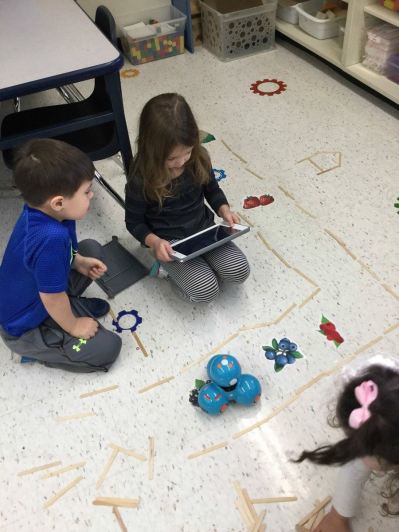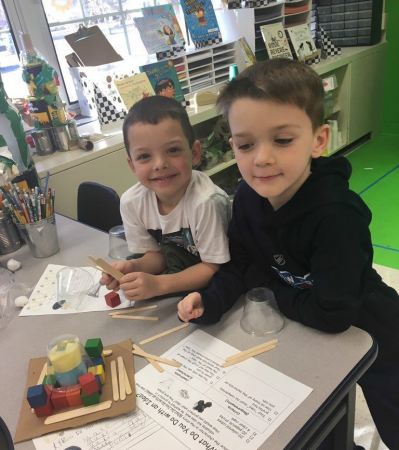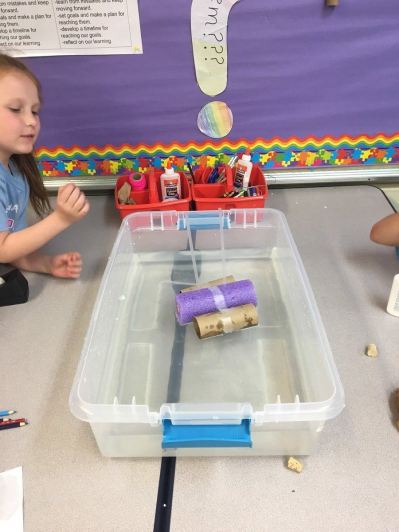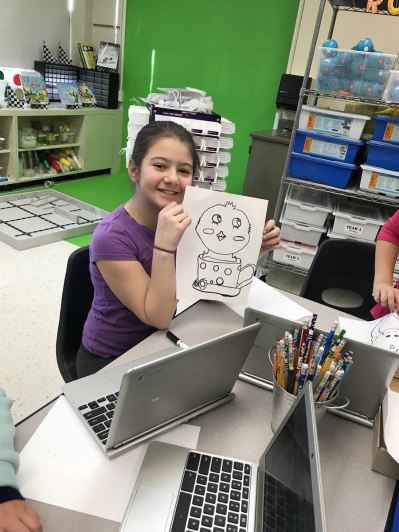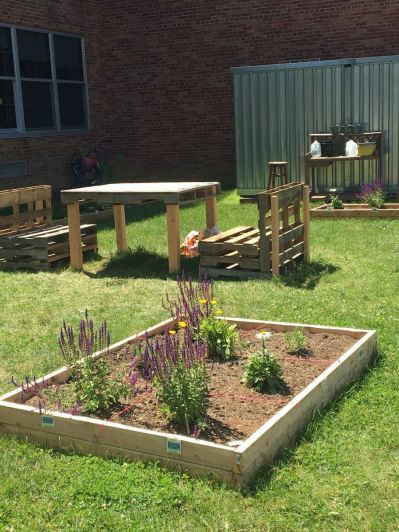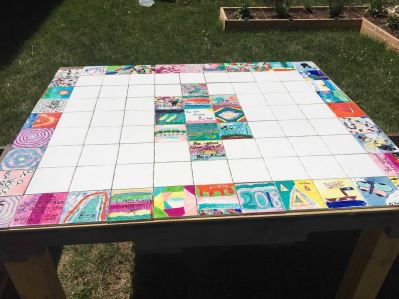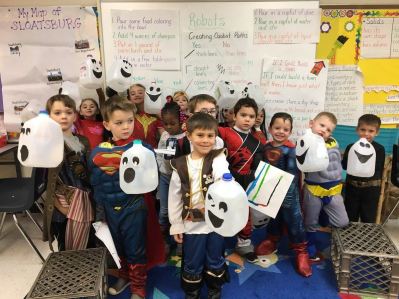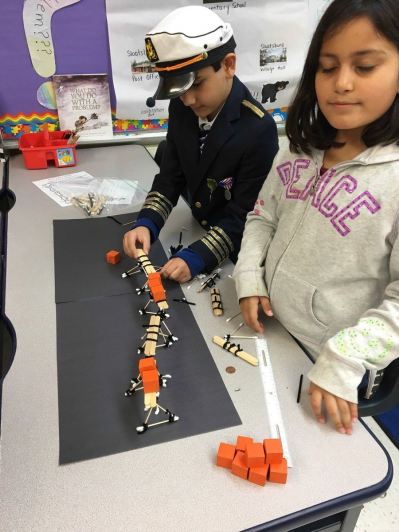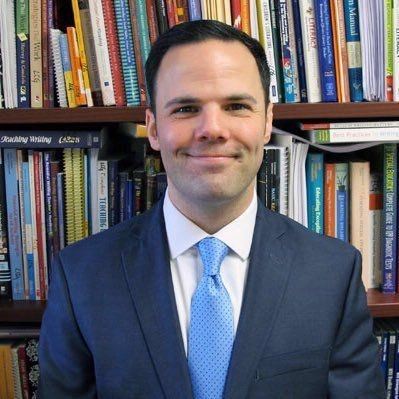Sloatsburg Elementary School - Creators’ Cove: The Evolution of a Makerspace Mindset
Sloatsburg Elementary took thoughtful action to establish a makerspace mindset, in which the skills of collaboration, creativity and critical thinking have been integrated within varying units of study. Sloatsburg Elementary is a Title I community public school, based within the village of Sloatsburg, New York (a suburban/rural region), serving approximately 215 students in Kindergarten through Grade 5.
An Inquiry
By Joseph Lloyd, Principal, Sloatsburg Elementary, lloyd@sufferncentral.org
During the fall of 2015, I was beginning my second year as the Principal of Sloatsburg Elementary. Fresh off my first year, I was excited about the relationships that I had established with our learning community. I was ready to begin adding new ideas and concepts into our school’s program. In late September, I was excited to be attending a workshop facilitated by David Jacob and Helen Pashley called “Getting Started with Makerspace.”
This class provided me with my first real opportunity to explore the purpose and philosophy of makerspace and how it could connect to both a school and district's vision/mission for student learning. As part of this workshop, we were also tasked with considering the facility design, management, professional development, and funding. While I left both inspired and full of ideas, I was overwhelmed and knew that I needed to visit a makerspace in action.
Later during the same year, Brian Alm—who was the Haldane High School Principal at the time—provided me and several other colleagues across the county with the opportunity to visit his school district (a beautiful K-12 campus) situated in Cold Spring, New York. As part of this tour, we were able to visit the Haldane Elementary School makerspace. On our way to this space, I was excited to observe an abundance of new resources being used by students. Upon entering the school’s makerspace, I had noted that this space, fitted with furniture and a few resources, was generally empty.
“Where were the devices and resources? Where was all of the action?” I asked myself.
Recognizing my wonderment, Brent Harrington –the Elementary School Principal at the time—had shared with our group that many of the resources within the school’s makerspace were being loaned by the classroom teachers. More importantly, I learned that it was the school’s intention to have the work of collaboration, creativity and critical thinking live within the daily instruction of classroom teachers, not necessarily within the makerspace. This was an important learning moment for me, and resonated with my thoughts throughout the following year.
Flash forward to the spring of the 2016-2017: our school’s new Instructional Facilitator, Michele McKiernan and I, had been holding several brief but informative discussions about what our school’s makerspace might offer students. Meanwhile, our staff met to conduct a strategic planning process. Using our monthly faculty meeting, we worked together in order to identify school strengths, weaknesses, opportunities and challenges while looking forward to the next school year. This seemed like a logical next step for us and acted as a needs-assessment strategy that our school district, Suffern CSD, had utilized on a larger, community-based scale.
Our school’s strategic planning work had demonstrated a need for us to integrate more opportunities in which students could tap into their personal interests, enhance their social skills, and apply their critical thinking skills. While discussing this with teachers, Michele and I were confident that one way that we could achieve these goals was through the development of a dedicated school space where students would have time to collaboratively identify problems, generate multiple solutions and reflect upon their progress.
As we considered the facility design, we found an opportunity to use a computer lab that had been underutilized. We felt comfortable and ready to transform this lab into our school’s future makerspace.
The Implementation
By Michele McKiernan, Instructional Facilitator, Sloatsburg Elementary School, mmckiernan@sufferncentral.org
The role of the Instructional Facilitator is fluid, defined by the needs of the staff and the students. As someone who was new to the role, that meant that it wasn’t always clear to me what my job entailed, or whether I was even doing it well. I hadn’t been in the position for very long before discussing the idea of a makerspace with my principal; there were many uncertainties surrounding the concept. I wasn’t sure what I wanted the space to look like or what materials would work best and grow with our population; it was also a sweeping, evolutionary change for teachers.
However, I kept reminding myself of the line in the movie Field of Dreams: “If you build it, they will come.” To have a whole plan based around Kevin Costner doesn’t appear to be the most educationally sound method, but it’s what I was counting on; to be given the opportunity to build a program from the ground up is an innovative educator’s dream, and it’s especially exciting when you recognize its potential. Often, what comes hand in hand with potential is pitfalls, and it became my mission to avoid as many pitfalls as possible by learning from the mistakes and successes of others. How could I develop a self-sustaining, far reaching model that is not dependent upon a person—with minimal experience in computer science and engineering, by the way—but a philosophy?
With an interest in creating such an environment, our school prepared to develop Creators’ Cove (our version of a makerspace), during the spring of 2017. After visiting multiple programs throughout our county and speaking to several technology coordinators in both Rockland County and Westchester County, a list of materials to purchase was generated. This list included picture books related to STEAM, a maker cart with many replenishable resources, robots with different purposes to span the grade levels (Dash and Dot, Sphero, Ozobots, Cubelets), Makey-Makey kits, and rolling carts to make the materials transportable. After all, it was our goal for teachers to take what they needed to use in their classrooms, so we might as well make them “grab and go” style. I started to look at the space we had and realized that much of what was there could be used, but my original goal of making the space inviting to teachers and students kept gnawing at me. So, I set about creating an industrial feel to the room: one that said, “to invent, you need a good imagination and a pile of junk,” a quote by Thomas Edison. I collected materials from old science kits, made seating from old milk crates that I spray painted silver, asked our very talented (and very understanding) maintenance man Joe Galiano to not only paint me a green screen area but build a soundproof recording booth to create tutorials, and for a bit more ambience, made Lego blocks from cardboard boxes and cups and book holders to display our literature using cardboard and contact paper. When the kids looked around the room, I wanted them to see the ability to MAKE just about anything. When the space was created, we were ready to move forward with the curriculum design piece.
Once the materials were purchased, we started to design the curriculum to incorporate as many of the materials as we could within a spiraling curriculum that built upon the previous years’ experience.
Because the space was readily adaptable, we were able to focus our attention on the following generalizable goals:
- Generating teacher investment by connecting activities to the curriculum;
- Allowing ALL students an extended opportunity to work with both engineering and programming. Most programs I had seen extended this opportunity to small groups, rather than the whole population.
- Creating a plan that incorporated literacy skills;
- Implementing a co-teach gradual release model to increase teacher comfort level.
An initial and integral phase of our planning was determining practicable points in our school’s (K-5) curriculum maps, which could be enhanced within this space. It was critical to teacher investment that this curriculum was not seen as “something extra” to do, but as curriculum that meshed well with the components they were already teaching. To this end, I blended specific curricular units (across our school’s K-5 grade levels) along with supporting technology/tools, including:
Kindergarten - Introduction to Engineering and Robotics
Within this unit, students are introduced to the Engineering Design Process through the book What do you do with a Problem? After understanding how the design process works, students listen to We’re Going on a Bear Hunt and create their own binoculars. Using this foundation, they also work collaboratively to program robots to gather berries for the bear. This is a highly integrated approach designed to thematically immerse them in the foundational understanding of both engineering and computer science, and both Ozobots and Dash robots were incorporated into this unit (Engineering Materials, Ozobots, Dash and Dot).
First Grade - Community and Global Citizenship
Within this experience, students first listen to What do you do with an Idea? and then work together to generate ideas of how to protect their idea. In partners and small groups, students build structures around their “idea” and then test them. Students can then change their designs to enhance them. After, they listen to If I Built a House, and generate ideas, sketch designs, and build their own “dream room” (within the given requirements and constraints). After, they use Little Bits to add an electrical component such as a light. Then, they program their way through the neighborhood using Dash (Engineering Materials, Little Bits, Dash and Dot).
Second Grade - Solids & Liquids
In second grade, students listen to What is the World Made Of? and describe a secret solid based on its properties and characteristics. They also create sedimentary rocks using a variety of materials. After, they listen to A Rainbow of My Own and create a walking rainbow to show how liquid can travel through materials. Finally, after reading an excerpt of Horrible Harry and the Green Slime, students create different kinds of slime and compare the results using miscellaneous science materials
Third Grade - Water
During third grade, students listen to The Magic School Bus: Inside the Waterworks. Collaboratively, they work on using materials to represent/build a three-dimensional version of a water filtration system using a variety of materials. Using an Ozobot as the “water,” students use the color codes to program the Ozobot to move through the water filtration system (and have it spin or speed up when it is supposed to within the process). After, they listen to Who Sank the Boat? and given requirements and constraints, they must build a watercraft around a Sphero robot that can carry pennies across two feet of water using engineering materials, Ozobots, and Spheros.
Fourth Grade - Magnetism/Electricity & the Brain
To parallel an electricity unit, students listen to Galimoto and discuss ways in which to use wire in circuitry. Then, they take apart Operation games and try to determine how they work before generating ideas for their own Operation game. They must create their own game with a complete circuit using the Maker Cart materials, or they can program it in Scratch using the Makey-Makey circuit board. Emphasis will be on the feedback process, as students listen to Thanks for the Feedback and offer constructive praise and criticism to their peers so that they can use this information to modify their game. Students then work with Cubelets, as their input/output and sensory cubes parallel how the human brain works, which is also a part of their curriculum (Maker Cart, Makey Makey, Cubelets)
Fifth Grade - Environmental Stewardship- Butterfly Garden
Project-Based Learning was one of our district’s initiatives this year. As one fifth grade class was involved in a project, we thought it would be best to parallel project-based learning with the other fifth grade class. Therefore, this unit was far more focused on science, engineering, and math instead of robotics. After reading The Kid Who Changed the World, students began to understand that small changes can make big differences. They read articles on the shrinking bee population and decided to create a Butterfly Garden to attract pollinators. In groups of six, students designed their own garden beds with a required area of 24 square feet, projected costs of pollinator friendly plants, found the volume of soil needed, and put together their own garden beds in the back of the school. Fifth grade students made a commercial using the green screen in which they discussed the importance of creating pollinator friendly gardens. They also created a table and seating area out of wooden pallets and tiled it with inspirational phrases and drawings.
There were rubrics designed around K-2 expectations and 3-5 expectations in Creators’ Cove so that there was always a focus on the skills we wanted to foster such as creativity, collaboration, demonstrating determination, critical thinking, and presentation skills. These are posted on the wall in our Creators’ Cove and referred to often as a reminder of our goals in working in a collaborative space.
Results
During the 2017-2018 school year, every grade level was examined on a consistent basis for an entire trimester. Kindergarten and grade two were seen the first trimester, grades one and four were seen during the second trimester, and grades three and five visited during the third trimester. Time spent in Creators’ Cove focused primarily on the Engineering Design Process and Computer Science and Programming, while assisting in developing communication, collaboration, feedback, and presentation skills. All teachers who brought their classes to Creators’ Cove were expected to be active and relevant co-teachers of the lesson. Because that was the expectation, lessons plans were written and shared with classroom teachers prior to their scheduled time, so that they could read the lesson and ask questions if necessary. Classroom teachers were encouraged to use questioning techniques with their students rather than guiding them to decisions.
Additionally, we realized that the design and materials purposed for this space aligned with our school’s Green Team goals (reusing and recycling materials from both the cafeteria and art room).
With the overlap of these two school-wide initiatives (Green Team & Creators’ Cove), we conducted several theme-based projects on Halloween and Thanksgiving, in which recycled materials were repurposed for student projects. Our enthusiasm trickled out into the community as well; we asked them to contribute towards our goals, which further strengthened our communication of initiatives.
Reflection and Next Steps
After the first year of implementation, we asked teachers for their feedback regarding Creators’ Cove. 88.9% of teachers stated that their time in this space integrated either very easily or easily into their day. 100% of teachers found that the curriculum aligned well with their existing curriculum. Equally important, teachers reported that 100% of students viewed their experience in Creators’ Cove positively. As time in the classroom is always a very challenging dynamic, it was encouraging to receive feedback such as, “it was difficult scheduling the Cove last year, since it was during my literacy block, but worth it because the kids LOVED it!” and “we found a lot of value in Creator's Cove last year. My kindergarten class was excited to go each time. There were so many great discussions, exposure to good literature, and active engagement. Each session was developmentally appropriate and hands on. Creator's Cove is a perfect setting for kindergarten learning.”
As we move into the second year of implementation, we are asking teachers to incorporate some of these philosophies and ideas into their own classroom practice. To that end, one of our third-grade teachers asked for support with using the Green Screen to create videos about different countries. We will revisit our lesson plans to improve their clarity and try new ideas as well. Teachers will continue to improve upon their own growth mindset so that they can instill that within kids as well. In time, we remain confident that all students will receive several learning opportunities in Creators’ Cove again this year. Kevin Costner was onto something...we built it, and they came. They left with a positive outlook, an understanding of engineering and programming, stronger question techniques, and the adaptation of a fail forward philosophy. Moreover, we believe that with continuous and spiraling exposure to the Engineering Design Process and Computer Science, the skills of our entire learning community will only be strengthened. It is our hope that teachers will gradually transfer these ideals into their own classroom practices, further establishing the makerspace mindset.
About the Authors
Joe Lloyd is the principal of Sloatsburg Elementary School. He has worked in the field of education for 17 years. Prior to joining the Suffern Central School District in 2014, he was an assistant principal for seven years and a classroom teacher for five years in the North Rockland Central School District. Joe is honored to be working alongside a dedicated faculty, staff & community. He enjoys hiking with his family.
Michele McKiernan is currently an Instructional Facilitator/Math Specialist at Sloatsburg Elementary School. She has been married for 21 years to her husband Joe, and has four children named Thomas, Kayla, Cristina, and John who all share the same birthday (and no, they’re not quadruplets!) She enjoys pursuing new challenges in education, which is why she has been both a special education teacher and general education teacher, as well as an elementary school teacher and middle school teacher. In her free time, she enjoys cooking, reading, and playing sports and games with her family.






